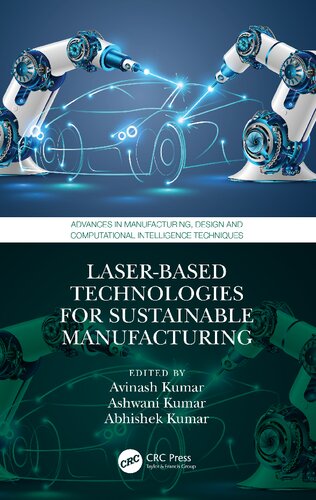Laser Based Technologies for Sustainable Manufacturing 1st Edition by Avinash Kumar 9781000907971 100090797X
$50.00 Original price was: $50.00.$25.00Current price is: $25.00.
Laser Based Technologies for Sustainable Manufacturing 1st Edition Avinash Kumar – Ebook Instant Download/Delivery ISBN(s): 9781032392738,9781032514703,1032392738,1032514701

Product details:
- ISBN 10: 100090797X
- ISBN 13: 9781000907971
- Author: Avinash Kumar
Laser-based Technologies for Sustainable Manufacturing
Table contents:
1 Introduction to Optics and Laser-Based Manufacturing Technologies
1.1 Introduction
1.2 Optics
1.2.1 Concepts of Optics Geometry
1.2.2 Optics Geometry
1.2.3 The Approximation of Ray
1.2.4 Reflection
1.2.5 Law of Reflection
1.2.6 Specular and Diffuse Reflection
1.2.7 Refraction
1.2.8 Law of Refraction
1.3 Mirror and Lenses
1.3.1 Mirror
1.3.2 Lens
1.4 Laser
1.4.1 Lasers Types
1.5 Lasers in Manufacturing
1.6 Laser Metal Deposition
1.7 Lasers in Additive Manufacturing
1.7.1 Use of Lasers in Additive Manufacturing
1.8 Laser Parameters in 3D Printing
1.8.1 Operating Wavelength
1.8.2 Average Power Pulse Energy Intensity
1.8.3 Pulse Duration
1.8.4 Beam Quality and Focused Spot Size
1.9 Laser for 3D Printing Technology
1.9.1 Stereolithography (SLA)
1.9.2 Selective Laser Sintering (SLS)
1.9.3 Selective Laser Melting (SLM)
1.9.4 Laser-Guided Net Engineering (LENS)
1.10 Laser-Based Macro-Scale Metal AM Challenges
1.10.1 Interface Defects
1.10.2 Powder Contamination
1.10.3 Pre-Processing Software
1.10.4 Experimental Design
1.11 Industrial Applications
1.11.1 Photolithography
1.11.2 Marking and Scribing
1.11.3 Noncontact Measurement
1.11.4 Scientific Applications
1.11.5 Clinical and Medical Applications
1.12 Conclusion
References
2 Physics of Laser–Matter Interaction in Laser-Based Manufacturing
2.1 Terminology
2.2 Energy Levels and Transitions
2.2.1 Electronic Levels
2.2.2 Vibrational Levels
2.2.3 Rotational Levels
2.3 Excitation
2.3.1 Stimulated and Spontaneous Emission
2.4 Population Inversions
2.5 Amplification and Oscillation
References
3 Current Issues, Developments, and Constraints in Additive Manufacturing
3.1 Introduction
3.2 Fundamentals of AM
3.2.1 Process
3.2.2 Technique
3.2.3 Materials
3.2.4 Understanding the Requirements of Standards
3.3 Recent Trends
3.3.1 Hybrid Process
3.3.2 Micro Manufacturing
3.3.3 Process Optimization
3.3.4 4D Printing
3.3.5 Control and Monitoring
3.3.6 Data Acquisition
3.3.7 Sustainability
3.4 Applications
3.4.1 Biomaterials
3.4.2 Aerospace
3.4.3 Buildings
3.4.4 Protective Structures
3.4.5 Orthopedics
3.4.6 Repair and Remanufacturing of Damaged Components
3.4.7 AM for Space Resources
3.5 Limitations of AM
3.6 Conclusion
References
4 Laser-Based Additive Manufacturing
4.1 Introduction
4.2 Laser in Additive Manufacturing
4.2.1 Classification of Laser-Based Additive Manufacturing
4.2.2 Design for Additive Manufacturing Processes
4.2.3 Post-processing of Additive Manufactured Components
4.3 Defects in Laser-Based Additive Manufacturing Processes
4.4 Application of Laser-Based Additive Manufacturing Processes
4.4.1 Medical and Dental Applications
4.4.2 Automobile Application
4.4.3 Aerospace and Military Application
4.5 Comparison of Laser-Based Additive Manufacturing
4.6 Current Issues, Challenges, and Future Scope
Acknowledgement
References
Abbreviation
5 Prospects of AI and ML in Laser-Based Manufacturing Technologies
5.1 Introduction
5.2 Role of ML in LBM
5.2.1 DL-Based Predictive Visualization of Fiber Laser Machining
5.2.2 Using ML, the Effects of Laser Energy Uncertainty on Temperature Changes in Directed Energy Deposition
5.2.3 ML-Based Challenges
5.3 Role of AI in LBM
5.3.1 AI Challenges
5.4 Conclusion
References
6 Application of Laser Technology in the Mechanical and Machine Manufacturing Industry
6.1 Introduction
6.1.1 Application of Lasers
6.1.2 Advantages of Lasers
6.1.3 Limitations of Lasers
6.2 Current Tools and Techniques Used in Mechanical and Machine Industry
6.2.1 Laser Cutting, Drilling, and Piercing
6.2.2 Laser Welding
6.2.3 Additive Manufacturing
6.2.4 Various Techniques Used for Additive Manufacturing
6.2.5 Suitable Alternatives to Improve the Existing Technology
6.3 Summary, Conclusion, and Future Challenges
References
7 Application of Laser-Based Manufacturing Processes for Aerospace Applications
7.1 Introduction
7.2 LAM, a Viable Option for the Fabrication of Aerospace Components
7.2.1 LAM processes
7.3 Laser Powder Bed Fusion
7.4 Laser-Directed Energy Deposition
7.5 Optimization of Parameters
7.6 Hybridization of the Process
7.7 Mitigation of Stresses
7.8 General Solutions to the Applications Through Findings
7.9 Conclusion
References
8 Laser Micromachining in Biomedical Industry
8.1 Introduction
8.2 LMM and Texturing
8.2.1 Laser Systems
8.2.2 Applications in Biomedical Industry
8.3 Lasers and Materials LMM Devices
8.3.1 Materials for LMM Devices
8.3.2 Common Industrial Lasers
8.3.3 System Considerations
8.3.4 Processing Considerations
8.4 Recent Trends in Biomedical Devices
8.4.1 Bio-Implants
8.4.2 Surgical Tools
8.4.3 Lab on Chip
8.4.4 Bio Sensors
8.4.5 Prosthetics
8.4.6 Angioplasty
8.4.7 AI and Computer Software
8.5 Challenges in Biomedical Industry and Solution for Future
8.6 Conclusion and Future Scope
References
9 Effect of Laser Surface Melting on Atmospheric Plasma Sprayed High-Entropy Alloy Coatings
9.1 Introduction
9.2 Laser-Based Surface Modification Techniques
9.2.1 Laser Surface Texturing
9.2.2 Laser Cladding
9.2.3 Laser Shock Peening
9.2.4 Laser Surface Melting
9.2.5 Laser Hardening
9.2.6 Laser Surface Alloying
9.2.7 Laser Glazing
9.3 Laser–Material Interaction
9.4 Area of Applications
9.4.1 Automobile Applications
9.4.2 Aerospace Applications
9.4.3 Biomedical Applications
9.4.4 Nuclear Applications
9.5 High-Entropy Alloy
9.6 Experimental Procedure
9.7 Results and Discussion
9.8 Conclusions
9.9 Future Scope
Acknowledgments
References
10 Laser Processing Technologies in Electronic and MEMS Packaging for Advancement of Industry 4.0
10.1 Introduction
10.1.1 Role of Sensors
10.1.2 Advancement
10.2 The Evolution of Biosensors
10.2.1 Essential Idea of Biosensors
10.2.2 Nano Materials
10.2.3 AI Biosensors
10.2.4 Flexible Bioelectronics Materials and Integration
10.2.5 Wireless Communication
10.2.6 Machine Learning
10.2.7 Smartphone-Based Platform
10.2.8 Designs in the Semiconductor Enterprises and Packaging Foundries
10.3 Laser Drilling
10.3.1 Laser Cutting
10.3.2 Accentuation
10.4 Conclusion and Future Scope
10.5 Future Scope
People also search:
laser-based technologies for sustainable manufacturing
sustainable tech brands
sustainable tech companies
environmentally friendly tech companies
laser manufacturing companies
You may also like…
Computers - Computer Science
Digital Twin for Smart Manufacturing 1st Edition Rajesh Kumar Dhanaraj
Engineering - Robotics & Artificial Intelligence
Engineering - Automotive
Computers - Hardware
Engineering - Industrial Engineering & Materials Science
Biology and other natural sciences - Plants: Agriculture and Forestry
Chemistry - Technical & Industrial Chemistry
Technique - Industrial Equipment and Technology
Engineering - Environmental
Sustainable Smart Manufacturing Processes in Industry 4 0 1st Edition Ramesh Kumar












